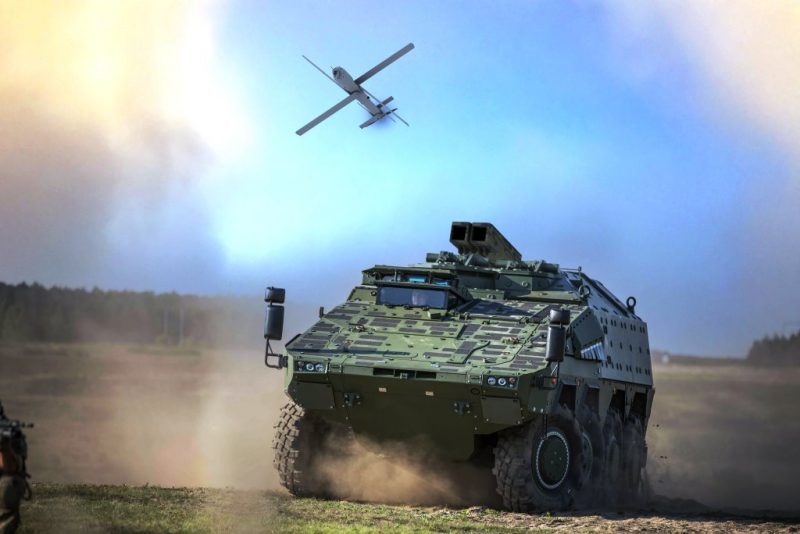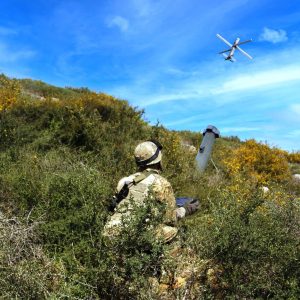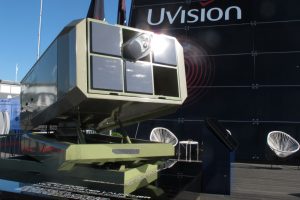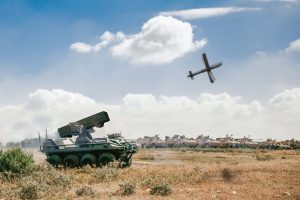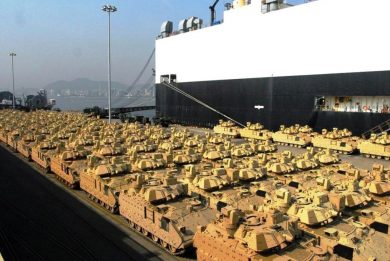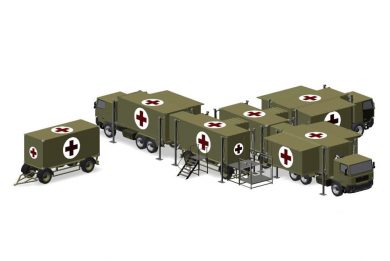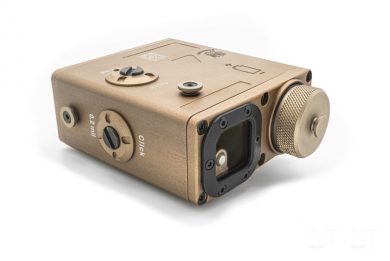Rheinmetall and UVision team to propose HERO Loitering Munitions on the European Market
Recent conflicts boosted the importance of Loitering Munitions (LMs) on the modern battlefield, however this category of weapon systems has been around for quite a long time, the first LM having been in service since 1982. One of the few, if not the only company that deals uniquely with LMs is UVision of Israel, which has developed the HERO family of systems, ranging from small, tactical, manpackable products up to systems with a strategic impact. In 2021 the Israeli company signed an agreement with Rheinmetall, through the subsidiary RWM Italia, located in Italy, to address the European market. The agreement came into force on 11 October 2021.
EDR On-Line was briefed on the UVision family of products and on the agreement contents by Dagan Lev Ari, UVision sales and marketing director, and by Romano Ricca, RWM Italia chief business development.
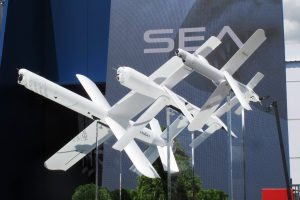
“Our company adopts a problem solving approach,” Dagan Lev Ari says, “as we are not looking at how to exploit technology in the military word but rather we do the opposite, starting from the problem to be solved, and in this very moment military forces have to deal with two different scenarios, high intensity and asymmetric ones.” Fighting against sophisticated adversaries means to evolve into an air superiority scenario, with a heavy electronic warfare threat denying GPS navigation as well as communications, hence giving problems to front line troops in terms of command and control, and calls for fire, all that often in urban or confined terrain. On the other hand we have low intensity conflicts, where one of the key issues is to locate targets, as they are disguised among ordinary population, hence a high risk of collateral damages, and are also very often time sensitive, as the scenario changes extremely rapidly.
“When we developed our HERO family of LMs we wanted to allow the soldier to achieve his mission neutralising the threat, with no collateral damages, remaining well protected, all this with an advanced but affordable system,” the UVision representative adds, defining the HERO as a game changer. While armed UAVs are expensive, require a considerable logistic footprint, and often raise political sensitivities, ground-launched missiles on the other hand are a good solution providing the threat location is well known in terms of location and timing. “We tried to put together the benefits of both solutions, the persistency of UAVs together with the terminal effectiveness of a missile, getting rid of disadvantages, and maintaining the man in the loop, through the Operator Control Unit (OCU),” Dagan Lev Ari tells EDR On-Line. While many LMs are based on existing fixed-wing UAVs to which a warhead has been added, the HERO family maintains the advantages of a UAV, in terms of persistence over the target, but has the flexibility of a missile in terms of angle of attack. “Beside being able to choose the time of attack and the direction of attack, if multiple HEROs are used we can attack from different directions in order to saturate the target defensive capabilities, the cruciform wing design allows us to play with the angle of attack, three buttons appearing on the OCU screen, for steep, medium and shallow angles, the operator being also able to select the fuse setting, between point detonation, fragmentation or delayed action,” the company Sales & Marketing Director points out. All this provides maximum flexibility, allowing optimising all parameters according to the type of target and the surrounding situation. A key element is the capability to abort the attack should the scene suddenly change; a yellow bar on the screen shows that the mission can still be abandoned, something that can be done until the last 6 seconds, when it is then too late to react.
Especially in near-peer confrontations the HERO survivability is a key issue. “First of all we choose a launch system, with pneumatic ejection, that is heat signature free, bringing the airframe at the required speed while the propeller opens up and the electric motor is started, secondly for all the versions that are already ob the market we checked the radar cross section, which is minimal, most radars seeing it as a flock of birds, and finally our data-link is fitted with an effective counter-jamming capability,” Dagan Lev Ari underlines. The launch system is powered by a compressed air bottle, which is carried separately from the system as safety measure.
Currently three members of the HERO family have been fully developed, sold to undisclosed customers, deployed, and some of them even proven in combat. These are the HERO 30, the HERO 120 and the HERO 400, all fitted with an electric propulsion system, which main characteristics are summarised in the following table.
| HERO-30 | HERO-120 | HERO-400EC | |
| Weight | 3 kg | 12 kg | 40 kg |
| Warhead | 0.5 kg | 4.5 kg | 10 kg |
| Range | 10 km | 40 km | 60 km, 150 km |
| Endurance | 30 min | 60 min | 120 min |
| Launch method | Single/Multi-canister | Single/Multi-canister | Rail, Single/Multi-canister |
The HERO-30 is the backpackable solution, ideal for providing Special Forces and Light Infantry with an autonomous loitering attack capability against light protected targets. An even lighter version was initially developed, but its range and payload were not considered sufficient. The whole system, one munition, the communications package with the antenna, and the OCU, can be transported by a single soldier, who would also carry his assault rifle and tactical vest. Each other soldier would be able to carry two extra munitions. It is to note that the standard antenna would provide a 5 km range, the 10 km limit being reached suing a bigger antenna. The OCU is user-friendly, the map appearing on the left of the screen, used for planning the approach route to the target area and the loitering zone, the video feed being shown on the right. Once the operator locks on the target the system switches in automatic tracking, leaving the option to abort and go back to loitering as explained earlier. “Our tracking system, which is based on picture comparison, proved to be able to follow a white vehicle over a bright desert surface,” the company representative told EDR On-Line.
The HERO-120 can be fitted with a recovery parachute, however this will impact the terminal effect, a smaller warhead being installed to give room for the chute. In its standard version the HERO-120 has an antitank capability; adopted by the US Marine Corps for its Organic Precision Fire Mounted (OPF-M) programme, the US decided to install the same warhead in use on their Javelin antitank missiles, which shows the flexibility of the UVision approach. The USMC purchased the multi-container launcher, currently available in 6- and 8-cell configuration, but according to UVision systems with higher numbers of cells can easily be developed. As for the HERO-400EC the parachute is standard, while its warhead is capable to penetrate a double reinforced concrete wall.
The HERO-120 and HERO 400 are usually installed over a mobility platform, i.e. light attack or light armoured vehicles, however UVision already successfully tested them from a naval platform, US Special Forces having tested the system from a very light attack boat. “We are currently working on launching our munitions from air platforms,” Dagan Lev Ari added. As for much longer ranges the company is developing the HERO-900 and the HERO-1250 versions, respectively with a 25 kg and a 50 kg warhead, ranges of 150 and 200 km, and endurance of 2 and 6 hours, both powered by a gasoline engine. No availability timeframe was provided.
Training is obviously another key issue, especially considering the range of those systems and the limitations of exercise areas where they can be allowed to fly. “Teaching a soldier how to use a HERO is much easier than forming a UAV pilot,” the company says, and to do so UVision developed a simulator linked to the system OCU and a launcher mock-up, but is working on an even smaller solution that will se an app installed directly on the OCU, providing two or three different tactical scenarios. Another obvious issue is cost. “The price per unit of one of our system is 60 to 80% less than that of an equivalent antitank missile,” the UVision Sales & Marketing Director states.
As anticipated, the USMC is already a customer, the systems being produced by UVision USA Corporation Northern Virginia, another production line having been created in India, where the Israeli company set up a joint venture, known as AVision, with Aditya Precitech.
Looking at the European Market, UVision decided to team with one of the defence industrial champions of the Old Continent, Rheinmetall.
“The agreement between Rheinmetall and UVision is very articulated, and will evolve according to the business evolution,” Romano Ricca, RWM Italia chief business development explained. Specialised in the development and manufacturing of countermining systems, medium to large calibre ammunition and warheads, this Italian subsidiary of Rheinmetall is skilled in electronics, mechanics and explosives, all what is needed, depending on business, to get to a co-production of the HERO.
The first step will definitely be the search for customers, and here the strong Rheinmetall footprint in many European nations will be key in promoting the HERO family. To do so the product will have to evolve to cope with EU regulations, and here the Rheinmetall expertise will be of key importance in aligning the available version of the HERO to those standards. “We have the right know-how to bring the current product to NATO standards, and to eventually customise it for future European customers,” Romano Ricca tells EDR On-Line.
While this is true for the aforementioned three existing versions, “for the HERO-900 and HERO-1250 we look forward cooperating since now in the latest part of the development in order to have a single product, that can be marketed worldwide,” Ricca tells EDR On-Line, although flexibility to cope with customers requirements will remain.
Rheinmetall’s subsidiary RWM Italia will act as prime contractor towards European customers, and when contracts will come it will carry out the production of some elements and the system assembly, as well as providing Integrated Logistic Support. The two RWM Italia sites would be interested by this cooperation, the one in Ghedi, northern Italy, for the partial production and assembly, and the facility in Sardinia for the loading of the warhead. A success of the HERO on the continental market would lead to an increase in the workforce, which is currently around 350 manpower.
As Dagan Lev Ari and Romano Ricca underlined, the agreement is open to further extensions and EDR On-Line understood that it also includes the intention to jointly develop new products in a second phase of the cooperation.
Photos courtesy Rheinmetall and P. Valpolini

